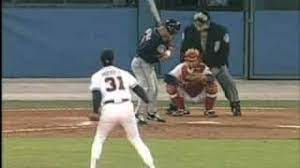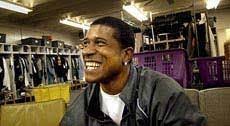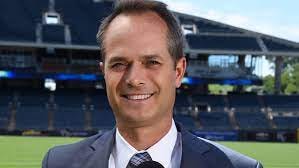Why pitchers don’t catch pop-ups
Traditionally, spring training starts with PFPs which stands for Pitcher Fielding Practice although position players sometimes replace the word “Fielding” with another word starting with “F” and I’ll now give you exactly one guess what that “F” word is.
(Yes…ballplayers are profane and if that’s what you’re currently thinking, you seem to have guessed the correct word.)
And since every season starts with pitchers practicing their fielding, now seems like a good time to talk about pitchers and how they’re regarded by the rest of the team when it comes to playing defense.
And away we go…
Many Big League pitchers were the best all-around player on their high school or college team and they might have also been the football team’s quarterback and basketball team’s power forward and they still think of themselves as terrific athletes and good hitters, capable of playing shortstop in a pinch and most Big League position players think those Big League pitchers are completely delusional.
Here’s the deal on that.
When I asked a position player why pitchers who were good hitters in college get to the Big Leagues and can’t hit water if they fall out of a boat, he said once you sign a contract and become a professional ballplayer you get sent down the “hitter” track or the “pitcher” track and by the time you reach the Big Leagues a professional hitter has seen thousands and thousands of pitches a pitcher hasn’t.
(This is also why position players who used to be pitchers think they can still pitch which leads to some goofy moments in blowouts, but that’s a different subject for a different day.)
So pitchers who used to be good hitters are out of practice and the 98-MPH fastballs with nasty movement they’ll see in the major leagues bear little resemblance to the 89-MPH straight fastballs they crushed in high school.
And pitching is so important that they want pitchers working on pitching-related tasks and not hitting, which a pitcher isn’t going to do that much anyway unless his last name is Ohtani. And now they’re using the DH in both leagues so you and the pitchers who still think they can do it can forget about hitting.
Covering first base
Each and every time a ball is hit to the left side of the pitcher’s mound the pitcher is supposed to break toward first base just in case the first baseman is the one fielding the ball. The pitcher can’t wait to see if he’s needed because if he does that he’ll be late and screw up the play and this is so fundamental they work on it the first day of spring training and yet every year some pitcher forgets to cover first, which is one of the reasons position players sometimes hold them in low regard.
“Jesus, dude…you got one job and you forgot to do it.”
Pitchers are so notoriously bad about remembering to cover first base, catchers will yell “Get over!” every time a ball is hit to the first base side of the mound.
When CC Sabathia came over to the Milwaukee Brewers in 2008, he asked catcher Jason Kendall to remind him to cover first base and Jason asked CC how much he was making that year (if the internet is to be believed it was $11 million) and Jason suggested for that kind of money CC shouldn’t need a reminder.
BTW: Kendall loves Sabathia and thinks he was a horse that got them to the playoffs…but a lovable horse that might forget to cover first base.
Backing up bases
Teams have playbooks and the playbooks have diagrams for every type of ball that can be put in play and where all nine defenders are supposed to go (this one is for basic bunt coverage with a runner on second base) and not one of those diagrams suggests that a pitcher just stand still and watch everybody else play defense.
Once a pitcher gives up a hit they have to back up bases and they’re often late doing that and my personal opinion about why that happens is pitchers are either stunned or angry about giving up a hit (possibly both, depending on how unrealistic they are about their “unhittable” stuff) and it takes them a moment to switch gears from “pitcher” to “guy who has to deal with the mess the pitcher created.”
And that moment’s delay is often too much and they’re late getting where they’re supposed to be, which is what happened when a throw goes into the dugout or all the way to the backstop: the pitcher didn’t get to his assigned spot, which once again pisses off everybody else who went to the right spot.
Throwing to bases
Every season pitchers throw approximately eleventy-bajillion pitches from the mound which is 60 feet, 6 inches from home plate and they’re also throwing downhill, but when you get a pitcher off the mound and make them throw from flat ground and some distance that isn’t 60 feet, 6 inches away, a lot of them struggle to throw accurately.
They’re not comfortable and some of them can’t figure out if they should throw with their regular arm motion and let it rip or toss it gently and this is one of the reasons you see a pitcher field a ball to the first-base side of the mound and then run almost all the way to first base before flipping the ball to the first baseman…they’re afraid of throwing from some unfamiliar spot.
And they’re afraid because they might kill a first base coach or an umpire, which might not bother them all that much – depending on which first base coach or umpire got killed – but they definitely don’t want to look like jerks and get ridiculed by the infielders who are expected to make all kinds of throws with all kinds of arm angles from all kinds of spots and not endanger bystanders in the process.
And speaking of all kinds of throws…
There’s the full arm throw and the underhand toss and when he was trying to teach me to play first base (an experiment doomed by one of us not having enough talent and I still think it was him) Russ Morman taught me the “dart throw” where you put the ball by your ear and throw it just like a dart because first basemen have to make all kinds of weird throws to late-arriving pitchers and when I showed the dart throw to Dan Quisenberry, he said he wished someone had shown it to him while he was still playing baseball because it would have come in handy.
Comebackers
A comebacker is a ball hit back at the pitcher (not an investor in pornographic films like it sounds; an observation that indicates one of us has his mind in the gutter) and if a pitcher is going to handle those well he needs to finish in good fielding position (think Greg Maddux who has approximately 472 Gold Gloves) and Baseball Purists – guys who have never played baseball and had a 110-MPH line drive hit directly at their testicles – will advise pitchers to finish squared up to home plate.
Ask a pitcher and he might tell you (and I know this because I asked) that when a line drive is hit back to the mound a pitcher wants to protect two things:
1. His head and…
2. His crotch.
Which is why a lot of pitchers finish sideways. Finish sideways and you can’t get hit in the nuts and all you have to worry about is your head.
Also…
A coach told me a lot of Latin players don’t wear protective cups because they didn’t have them available when they were growing up, so finishing sideways is their way of protecting their ability to have children and I actually met a Latin player who lost at least one of his Family Jewels to a line drive, which, if you’ve still got your balls, is a hell of a conversations starter.
I met this guy for about 10 seconds two decades ago and I still remember his name – Josias Manzanillo – which tells you how big an impression that injury made on me because I’ve got close relatives whose names do not immediately come to mind and I just looked it up and Josias took a line drive in the testicles hit by Manny Ramirez who I’m guessing could hit a baseball pretty damn hard.
Give him credit, Josias picked up the baseball and threw Jim Thome out at home and then had “reconstructive” surgery which in my case would be replacing the guts I threw up after having my nuts crushed by Manny Ramirez.
Finally…why pitchers don’t catch pop-ups
Royals announcer Ryan Lefebvre is one my favorite ballpark guys to talk with, but we disagree about politics and whether or not pitchers should be allowed to catch pop flies and I don’t know about Ryan, but I take the pop-fly disagreement way more seriously.
Catching pop-ups is harder than people think because they’re spinning really fast and curve as the come down and if you’re directly under one when it reaches its highest point, you’re probably going to miss it and that’s what happened when you see a guy start backpedaling frantically and then fall on his ass while the pop-up drops behind him.
It’s not 100 percent and there are some terrific fielding pitchers – Zack Greinke is one of them – but pitchers often suck at covering bases or making throws from unfamiliar spots and their fielding ability is often held in low regard, so when a pop fly goes up, position players just want the pitcher to vacate the vicinity and get the hell out of the way and I’ve seen pitchers fail to do even that and make it tough on a position player by standing too close or running up and scaring the shit out of the player trying to make the catch.
A coach who I know would rather have his name left out of it once told me when things get goofy on the infield, nine-times-out-of-10 it involves:
“That guy.”
And pointed at the mound.
In conclusion…
Going forward is easier than going back or looking straight up, so the player moving forward takes charge on a pop fly (first and third have priority over the catcher and the middle infielders have priority over the corner infielders and everybody including talented beer vendors has priority over the pitcher). Also, the pitcher has the mound to deal with and they don’t want him stumbling over the pitching rubber or a rosin bag or falling off the back side of the mound which is just the kind of goofy thing a pitcher might do, so they basically want him to clear out and not screw things up for the people who are out there every day and not one night out of five.
And that’s why pitchers don’t catch pop-ups.










The reason why pitchers don't catch popups is the same as why it is easier for an outfielder to make a catch coming in on the ball than it is for an infielder going out on one. You are right on Lee.
Well I’m glad I got to this one. Such good baseball scoop. Also, “Here’s the deal on that.”